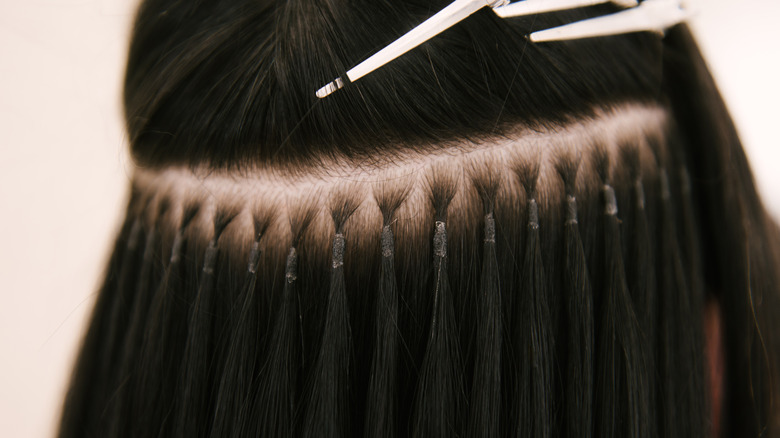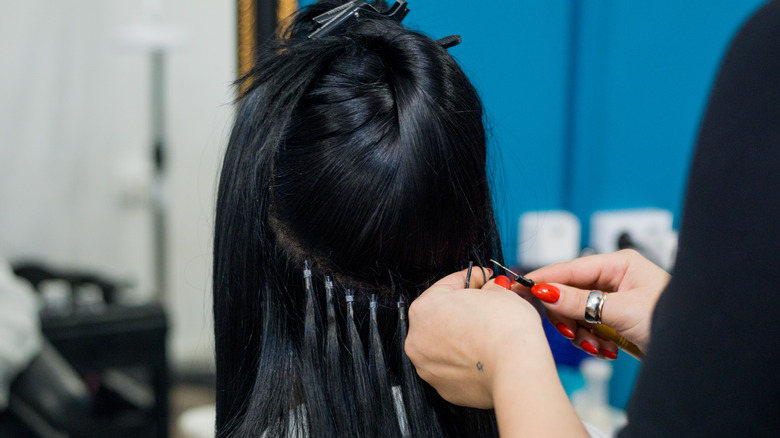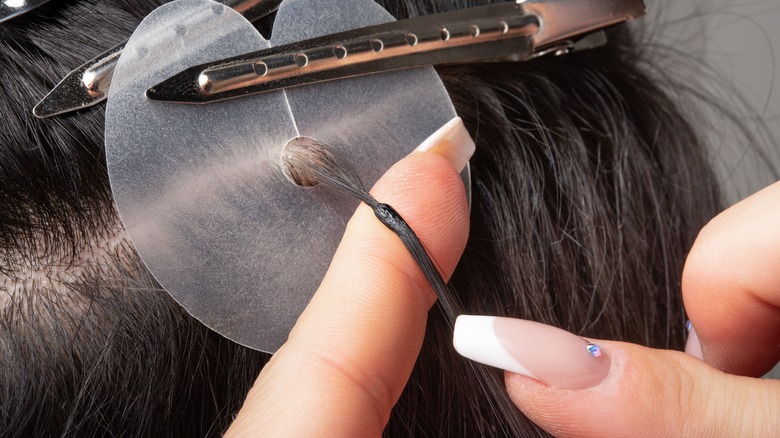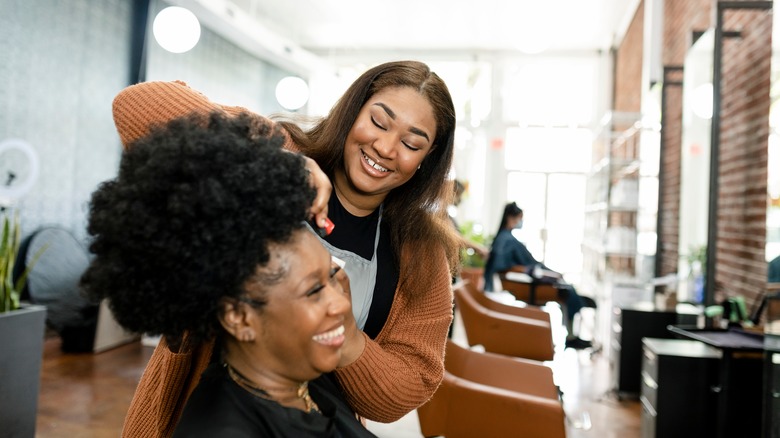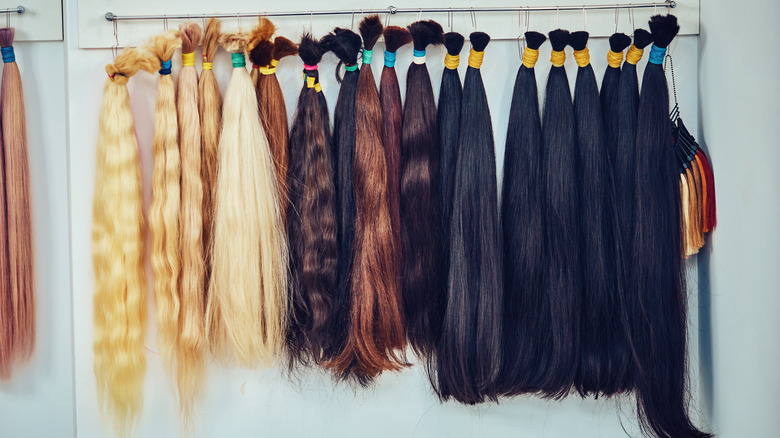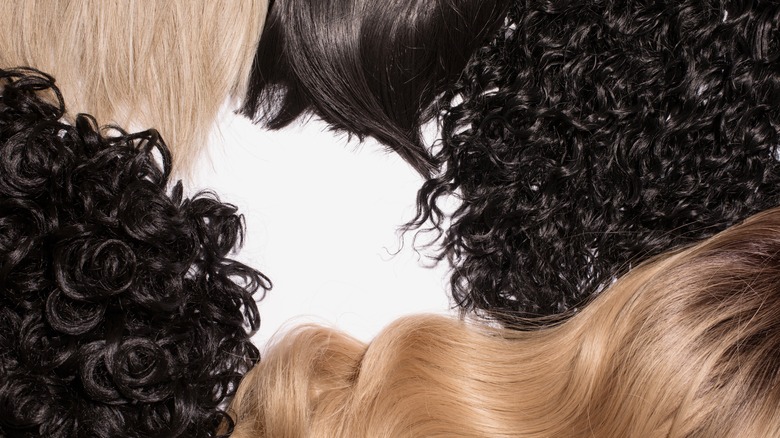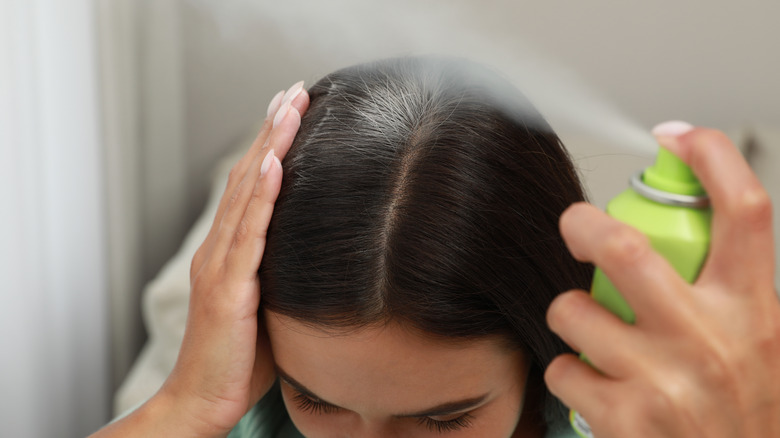Microlinks: The Hair Extension Trend As Blended As Your Foundation
Switching your hair from flowing, waist-length locks to a fashionable bob is as easy as a couple of snips with a pair of scissors. But if you're looking for a change in the opposite direction, it takes quite a bit of leg work. Extensions have been the go-to for women who want to add extra length or volume to their tresses for years, but the options are often uncomfortable, unblended, and unflattering. Sew-in and clip-in extensions have dominated the market as they're often the easiest and most inexpensive to apply. However, there's an option for hair extensions that promises a sleek, blended, and natural-looking result that lasts.
Microlink extensions have been around for years, but nowadays, they're growing in popularity as an option for those who want to avoid putting large amounts of tension on their natural hair, causing discomfort and damage. If you're looking for a safer, more free-flowing look than the other methods on the market, microlinks might be the choice for you.
What is a microlink extension?
Traditional extensions, whether tape-ins, weaves, or fusion, rely on some kind of adhesion to the natural hair. Weaves, also known as sew-ins, are the most popular thanks to their staying power and flexibility, but they require the natural hair to be first braided into cornrows. This process puts a lot of tension on the scalp and can damage thinner or finer hair types.
Microlinks, however, don't rely on glues to stay connected to the hair. Instead, small bunches of extensions are attached to the bottom layers of the natural hair with silicone or metal beads. This allows the top layer of your hair and part to remain as-is, leaving you with a more natural look. With this kind of extension, you also won't have to worry about the surprise appearance of tracks when you move your head — the tiny beads are much more low-profile than a full band of hair.
What are the benefits of microlinks?
In addition to their relatively natural look, microlinks promise to put less tension on the scalp, making for more comfortable wear and less damage once removed. They also don't utilize an adhesive, so they're generally considered one of the safest options on the market, especially if you're growing out your hair and are focused on maintaining its health.
For those with finer hair, microlinks provide a safer method of application that doesn't rely on braiding down beforehand. Those with curlier or thicker hair can usually withstand the tension from cornrows occasionally. Still, this style of braiding can lead to breakage if you're not careful, especially on less dense hair. Additionally, microlinks give you more placement freedom than many other options. If you're only looking to add a bit of volume, a few rows can be added to the inner layers of your hair to bulk it up a bit.
How long does it take to get done?
While microlink extensions might not take quite as long as a full sew-in installation, you should still expect to spend a few hours in the chair. Because microlinks are individually placed and usually use less hair per extension than the other types, it will take your stylist some time to properly place and clamp down each bead as they work around your head. During this process, it's also important that your stylist is not rushing through — proper tension when clamping and placement can ensure your extensions stay in the hair without damaging the pieces they're holding on to.
These appointments usually run from about two to four hours, depending on your desired result and what amount of hair you're working with. If you plan to add on a trim, color matching, or additional styling, you could be looking at a bit more time in the salon on top of the installation itself.
How much do they cost?
The cost of installing microlinks varies widely across a geographic area, desired results, and the skill level of your stylist, but a complete installation is usually in the $300 to $1000 range. This is the full package in some salons: hair, installation, and sometimes styling after the look is complete. Other stylists, however, will have you source your own hair beforehand, giving you a bit more flexibility in the final price you pay.
If your stylist expects you to purchase your own extensions, it's important to find something that matches your desired length as well as your natural texture and color. A full install will usually require about 100 to 250 hair tips, depending on your desired thickness; retailers usually sell tubes with 50 to 100 hair tips. The final cost will depend on the quality of the brand and texture of the hair, but you can expect to pay somewhere around $100 for a mid-range tube of extensions.
How long do microlink extensions last?
How long your microlink extensions last depends on how well you maintain them, but most installs last up to three months with regular salon upkeep. About every six weeks, it's recommended to head into the salon to shift up the beads and untangle any hair closer to the roots that have grown out. Because this style doesn't require braiding down, you can still wash your hair as usual while wearing your extensions, though it's essential to avoid any rough scrubbing that could move the beads around or cause tangles.
After your three months are up, you can reuse the hair from your last set if it appears in good condition, but the links themselves need to be replaced. Because this is a relatively damage-free style, you can jump right back into an install after removing your previous set. However, some breathing time between extension sets can help guarantee your scalp stays healthy and you avoid breakage.
What hair textures can get microlinks?
One of the main draws of microlinks over other types of extensions is that they work on various hair types. Straight, curly, and wavy hair are strong candidates for microlink extensions, though this rule has a few exceptions. If your hair is very thick or dense, it might be more difficult to create a seamless transition between the extensions and your natural hair, and you could risk losing track of the links themselves.
The opposite is true for hair that is ultra-thin or damaged. Hair that's already prone to breakage because of extreme bleach or heat damage likely won't do well with any added pressure or tension, so it might be a good idea to repair and trim your hair before jumping into another new style. Some people with thinning hair will do well with microlink extensions, but that's all up to the opinion of your stylist. If they don't think you have enough hair to conceal the beads and keep everything natural, you may have to seek another option.
How to maintain this style after your appointment
A major positive of microlink extensions is that they allow access to your roots, meaning you can wash and condition your hair as normal, just avoiding scrubbing motions in favor of gentle rinsing. With that being said, however, you might find yourself cutting back on your wash routine a bit to avoid disturbing the beads and causing slippage. Because of this, dry shampoo could become your new partner in crime. A spritz or two is enough to hold you over for an extra day, so you're not rougher on your hair than necessary.
Additionally, you should avoid using heat on your hair or steer away from high heat to prevent the melting of the microbeads. Try out a heatless style before bed, then wrap your hair in a bonnet and use a satin pillowcase, regardless of its texture. Friction only leads to damage and tangling, so keeping everything smooth and protected is the best way to ensure your extensions last as long as possible.
